To every plant there is a season
Author: Jim George
In an earlier post on “Going Native,” I’d written about the importance of layers in a bird-friendly garden in both time and space. Not only is it important for birds to have the spatial layers from native canopy trees down to the perennials and ground cover, but it’s also important for birds to have food across all four seasons and for pollinators to have food for the three growing seasons.
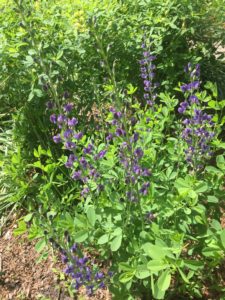 Blue wild indigo blooming in April garden.
Blue wild indigo blooming in April garden. It is natural to be inspired to add plants in the spring as the flowers and trees burst forth in bloom signaling the end of winter. However, the plants available then are usually those that bloom in the spring and don’t necessarily provide sustenance throughout the growing season. And the window for planting in the spring is very narrow since the summer heat comes quickly in the Piedmont, and new plants may struggle to make it through the summer.
Fall is a much better season to plant all types of plants including trees, shrubs and perennials. The cooler weather and winter rains will allow plants to establish their root systems. Even though plants lose their leaves, roots can continue to grow through our mild winters. So now is the time to plan for and add native plants to your garden to provide birds and pollinators sustenance throughout the year.
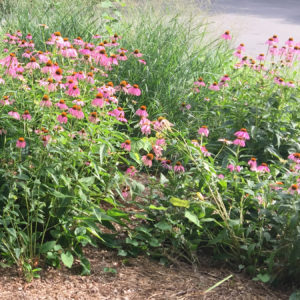 Purple coneflowers in summer garden.
Purple coneflowers in summer garden.You could start by taking an inventory of native plants already in your yard. Then you will need to find what sustenance these plants provide and the seasons of bloom and the setting of seed or fruit. For this you can use the native plant resources on our New Hope Audubon website including the spreadsheet on recommended native plants for the Piedmont. The goal is to have plants in bloom from spring to fall for the pollinators, and plants providing seeds and berries throughout the year for the birds.
Many of you may find that your garden is weighted toward spring blooming plants and lacks plants that bloom in late summer and fall. A few suggestions for late summer and fall blooming plants are Swamp Sunflower, native Asters, Joe Pye Weed, Goldenrods, and Blue Mistflower. Plants providing berries and seeds for fall and winter are very important so look for plants on the spreadsheet that set berries and seeds in the fall. They will be marked with SE for seeds and BE for berries. Examples include American Beautyberry and native Hollies for berries and native Sunflowers, Coneflowers, Black-eyed Susans, and native Grasses for seeds.
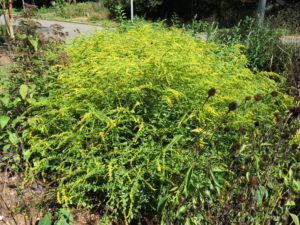 Drifts of Goldenrod brighten fall garden.
Drifts of Goldenrod brighten fall garden.Joe-Pye weed and Purple coneflower have set seed.
Pick plants based on their adaptability to the specifics of your yard in regard to soil type and the amount of sunlight. This will necessarily limit what you can grow, as it would in a true natural setting. Consider increasing the number of individual plants of a native shrub or perennial that is already a proven performer. Add new perennials in drifts of at least 5 or more plants. It is more important to have 5 plants of a single well-adapted species than one plant each of 5 species. Try to model natural settings where a single species may be present in large drifts. All the information needed for this planning can be found at our website. If you want further consultation, you can invite our Bird Friendly Habitat Certification team to survey your yard for native plants and make recommendations for additional plantings.
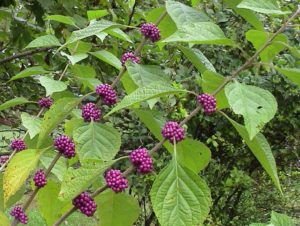 American beautyberry provides fall and winter fruit
American beautyberry provides fall and winter fruit– by Norm Budnitz
Also, as you plan and implement a garden that provides both beauty and wildlife sustenance throughout the year, don’t forget wonderful local resources like the NC Botanical Garden in Chapel Hill. Just wandering through the Botanical Garden in each of the four seasons gives you ideas for what is blooming in each season and what plants are providing seeds and berries. I’ve added a number of plants to my yard after seeing them in spring or fall at the Botanical Garden. They always have native plants for sale and also have annual fall and spring plant sales. See all of our recommended garden centers for other sources of native plants.
“To every thing there is a season,” and so it is with plants in your garden. I hope that you will enjoy the challenge of creating a bird and pollinator friendly habitat for ALL seasons.
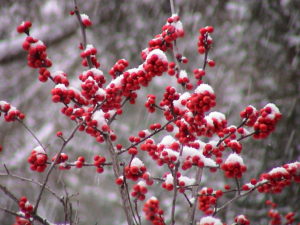 Deciduous holly with winter berries
Deciduous holly with winter berries-by Norm Budnitz
“The seasons are what a symphony ought to be: four perfect movements in harmony with each other.” ~Arthur Rubinstein
« Back to All Press